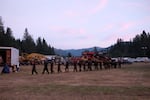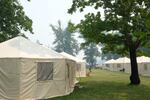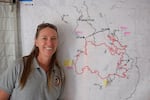During a busy firefighting season, there could be dozens of fires burning at any given moment in Oregon alone. And each of those fires might need hundreds of firefighters — and trucks, and bulldozers, and hoses, and helicopters — to get that fire under control. Those firefighters also need a place to eat and sleep and shower. And they need a way to communicate with each other out in the field, someone to treat their medical needs, tell them what the weather is going to be and how the fire is likely to behave.
Essentially, for every major fire that is fought in this country, a small city needs to be set up — often on the edge of the wilderness — to support the effort. It is a huge logistical challenge.

Firefighters are trained to walk in a line when out in the field. They keep that training in camp. Here, a team that has been working on the fire all day walks towards the food tent for dinner.
Sage Van Wing / OPB
That challenge is undertaken by incident command teams made up of 50 people from all over the country. They are trained to handle all the logistics needed to deal with any major disaster.
At a fire camp near Grants Pass in late July, Pacific Northwest Incident Command Team 3 gave "Think Out Loud" a tour. Team 3 has been deployed to help the cleanup after 9/11. They’ve also been sent in after earthquakes, hurricanes and the Challenger explosion. Every summer, they spend most of their time working on fires.

For every major fire, a small city must be set up to support the firefighting effort. Air-conditioned yurts house the command team setting up a communications network, medical facilities, weather forecasting, finance, etc.
Sage Van Wing / OPB
Logistics Section Chief Cindy Wedekind is retired, but she spends every summer at fire camps.
"It's the right thing for me to do," she said. "I have the skill set, so I feel like I need to give back to my community and continue to do it."
The incident command team is responsible for setting up a radio communications network, internet and phone services, food catering, medical services and port-a-potties. They also coordinate all the resources needed to fight the fire, from clothing to bulldozers.

Logistics Section Chief Cindy Wedekind poses next to one of the many giant maps outlining the current shape of the fire. Hundreds of these maps might be printed every day for each team in the camp, and out on the fire.
Sage Van Wing / OPB
The team comes up with the plan for how to deploy all those resources to fight the fire, according to the priorities that have been set for them by the designating agencies. In this case, that's the U.S. Forest Service Rogue River-Siskiyou National Forest.
"In camp itself, the intent is that it would be ... I won't say relaxed, but organized. Not chaotic," said Team 3 Incident Commander Noel Livingston. "It will be a safe place. So that people can come back here and get fed, get rested, take a shower, and be ready to go back out on the line the next day."

A station in the medical tent is always set up to deal with blisters. "The first week everybody's fine, the second week it's all feet." says Medical Unit Leader Jim Powell.
Sage Van Wing / OPB
Everyone in the camp works 12 to 18 hours a day for two weeks straight. Then they get a two-day break. But every fire always needs an incident command team to run the show.
That means that every 14 days, when one team needs a break, an entirely new team is called up to replace them.
There isn't much time to do much besides work, eat and sleep at a fire camp. But firefighter Carter Breedlove said they do try to joke around and make each other laugh when they can.

Brian Pickard is the squad boss of a hand crew of firefighters for GFP Enterprises, a contractor based out of Sisters, Oregon. Pickard says being responsible for 19 other people weighs on him every day: "They're the ones who do the work. It's just my job to keep them happy, keep them healthy, and get them home to their families."
Sage Van Wing / OPB
"Usually we get back to camp and set up our sleeping arrangements. We're all pretty close together," he said. "It's not too long after we get back that everybody's passed out for the night."
Working on a fire has become a way of life for many people we talked to.
“It’s probably the most satisfying work I’ve ever done,” said Incident Technology Support Specialist David Kholer. “You work with the most professional people you’ll ever meet. And you get paid for it.”

Chrissie Bodznick works for the U.S. Forest Service in Montana. She says she's lucky that she's part of a team that has a few women on it. "It's definitely one of the harder parts of fire for a woman, and one of the more interesting parts. Because you really are part of the lion's den."
Sage Van Wing / OPB

